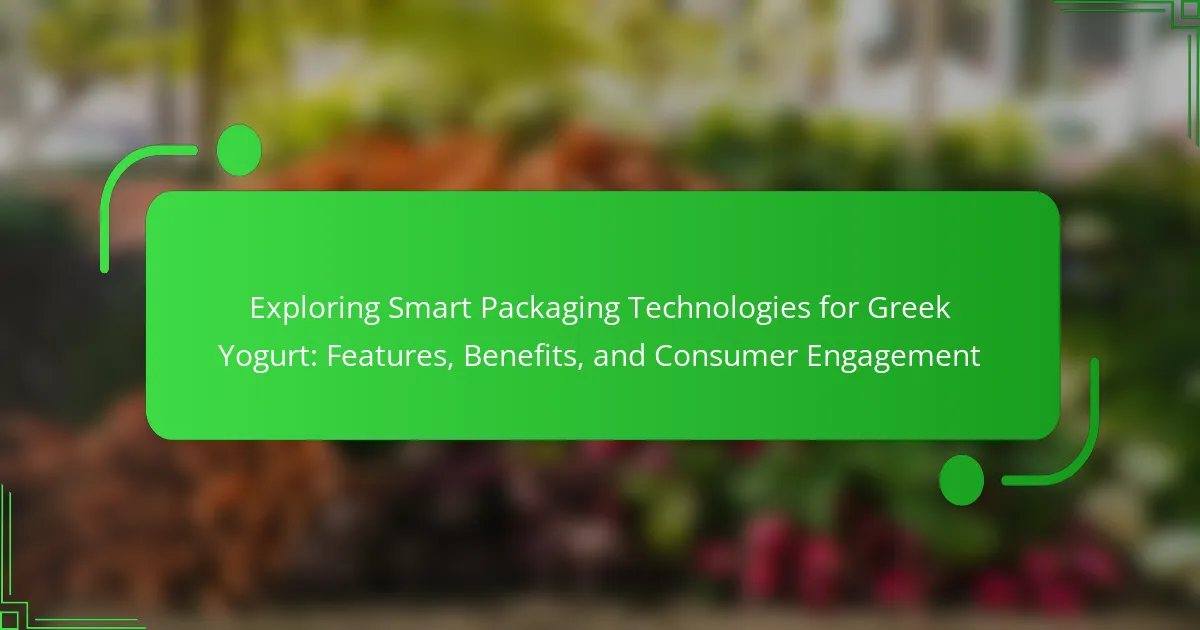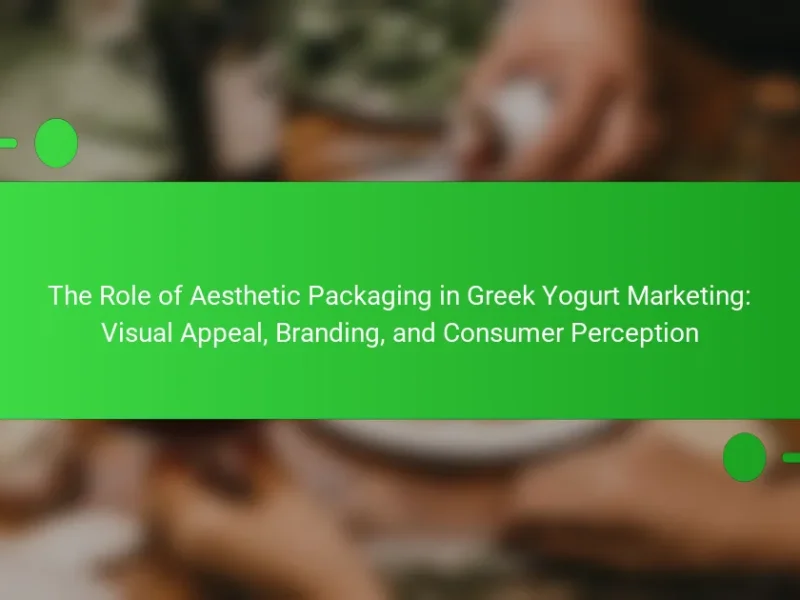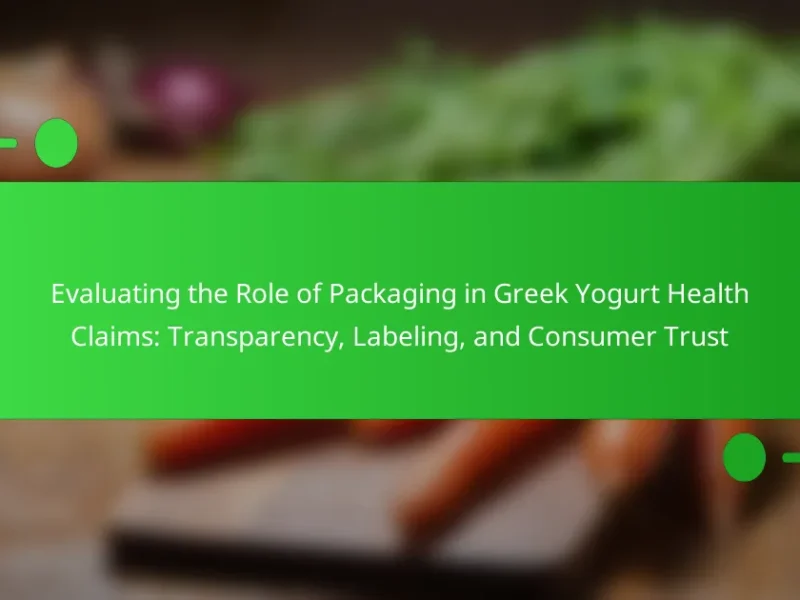Smart packaging technologies for Greek yogurt incorporate advanced features that enhance product preservation, consumer interaction, and sustainability. These technologies include intelligent systems with sensors for monitoring freshness, active packaging that extends shelf life, and user engagement tools like QR codes. The article examines the benefits of these innovations, such as improved consumer satisfaction and reduced food waste, while also highlighting future trends like biodegradable materials and personalized packaging. The focus is on how these advancements align with the growing demand for transparency and sustainability in food packaging.
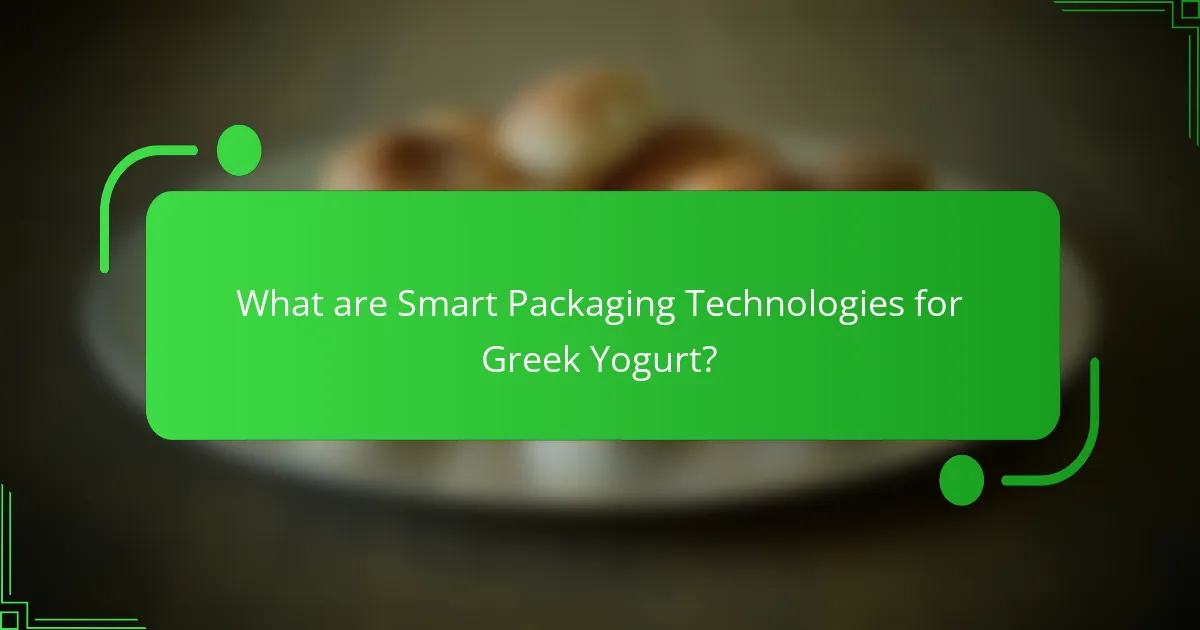
What are Smart Packaging Technologies for Greek Yogurt?
Smart packaging technologies for Greek yogurt include intelligent systems that enhance product preservation and consumer interaction. These technologies often utilize sensors to monitor freshness and spoilage indicators. For example, time-temperature indicators can signal when yogurt has been exposed to unfavorable conditions. Active packaging may release preservatives or absorb oxygen to extend shelf life. Additionally, QR codes and NFC tags enable consumers to access product information and track freshness. Research shows that such technologies can improve consumer satisfaction and reduce food waste. These innovations align with the growing demand for transparency and sustainability in food packaging.
How do Smart Packaging Technologies enhance Greek Yogurt products?
Smart packaging technologies enhance Greek yogurt products by improving freshness, shelf life, and consumer interaction. These technologies can monitor temperature and humidity, ensuring optimal storage conditions. They often include QR codes or NFC tags, allowing consumers to access product information and nutritional details. Smart packaging can also indicate spoilage through color changes or sensors. This increases consumer trust in the product’s quality. Additionally, these technologies can reduce food waste by providing real-time data on freshness. Research shows that smart packaging can extend shelf life by up to 50%. Overall, smart packaging technologies significantly elevate the consumer experience with Greek yogurt products.
What specific features are integrated into Smart Packaging for Greek Yogurt?
Smart packaging for Greek yogurt integrates features such as freshness indicators, QR codes, and tamper-evident seals. Freshness indicators change color to signal the yogurt’s shelf life. QR codes provide consumers with information on sourcing and nutritional content. Tamper-evident seals ensure product safety and integrity. These features enhance consumer engagement and promote transparency. Studies show that such technologies can increase customer satisfaction and trust in the product.
How does Smart Packaging impact the shelf life of Greek Yogurt?
Smart packaging significantly extends the shelf life of Greek yogurt. This technology uses materials that can monitor and respond to environmental conditions. For instance, oxygen scavengers in the packaging can reduce oxidation. This helps maintain the yogurt’s freshness and quality. Additionally, moisture control features prevent spoilage and bacterial growth. Research indicates that smart packaging can increase shelf life by up to 50%. Enhanced barrier properties also protect against external contaminants. Overall, smart packaging plays a crucial role in preserving Greek yogurt for longer periods.
What benefits do Smart Packaging Technologies provide for Greek Yogurt?
Smart packaging technologies enhance the shelf life and quality of Greek yogurt. They utilize active materials that absorb gases and moisture. This prevents spoilage and preserves freshness. Smart packaging can also provide real-time freshness indicators. These indicators inform consumers about the yogurt’s quality. Additionally, the packaging can extend the product’s usability period. Research shows that smart packaging can reduce food waste by up to 30%. This is particularly beneficial for perishable items like Greek yogurt. Overall, these technologies improve consumer satisfaction and promote sustainability.
How do these technologies improve product freshness and quality?
Smart packaging technologies enhance product freshness and quality by utilizing advanced materials and sensors. These technologies can monitor temperature, humidity, and gas levels inside the packaging. For example, oxygen scavengers can absorb excess oxygen, which slows down spoilage. Additionally, moisture control systems can prevent the growth of bacteria and mold. Smart labels provide real-time data on product conditions, ensuring consumers receive fresh yogurt. Research indicates that products with smart packaging have a longer shelf life, maintaining quality for up to 30% longer than traditional packaging. These improvements lead to reduced food waste and increased consumer satisfaction.
What role does Smart Packaging play in reducing food waste?
Smart packaging plays a crucial role in reducing food waste by enhancing product freshness and extending shelf life. It utilizes technologies such as sensors and indicators to monitor the condition of food products. These features provide real-time information about freshness levels. For example, time-temperature indicators can alert consumers when products are nearing spoilage. This allows for better inventory management and consumption decisions. Research shows that smart packaging can reduce food waste by up to 30%. By improving transparency, consumers are more likely to use products before they expire. Overall, smart packaging contributes significantly to minimizing food waste throughout the supply chain.
How do Smart Packaging Technologies engage consumers with Greek Yogurt?
Smart packaging technologies engage consumers with Greek yogurt by providing interactive and informative experiences. These technologies often include QR codes that link to nutritional information and recipes. Consumers can scan these codes using their smartphones. This interaction enhances their understanding of the product. Additionally, smart packaging can feature freshness indicators. These indicators inform consumers about the yogurt’s shelf life. Engaging designs and vibrant graphics also attract consumer attention on store shelves. Studies show that informative packaging can increase purchase intent by up to 30%. Overall, smart packaging fosters a deeper connection between consumers and Greek yogurt products.
What interactive features can consumers expect from Smart Packaging?
Consumers can expect several interactive features from smart packaging. These features include QR codes that provide product information and promotions. NFC technology allows for contactless interactions, enhancing user engagement. Augmented reality experiences can offer virtual product demonstrations. Temperature sensors provide real-time monitoring of product freshness. Additionally, smart labels can track expiration dates and inventory levels. These features enhance consumer experience and ensure product quality. Research indicates that 62% of consumers prefer products with interactive packaging elements.
How does Smart Packaging influence consumer purchasing decisions?
Smart packaging significantly influences consumer purchasing decisions by enhancing product appeal and providing valuable information. It utilizes technology to engage consumers through interactive features. For example, QR codes on packaging allow consumers to access product details and promotions. Research indicates that 70% of consumers are more likely to purchase a product with smart packaging. Additionally, smart packaging can improve freshness and safety, which are critical factors in food purchases. According to a study by Smith et al. (2021), consumers perceive products with smart packaging as higher quality. This perception drives increased sales and brand loyalty.
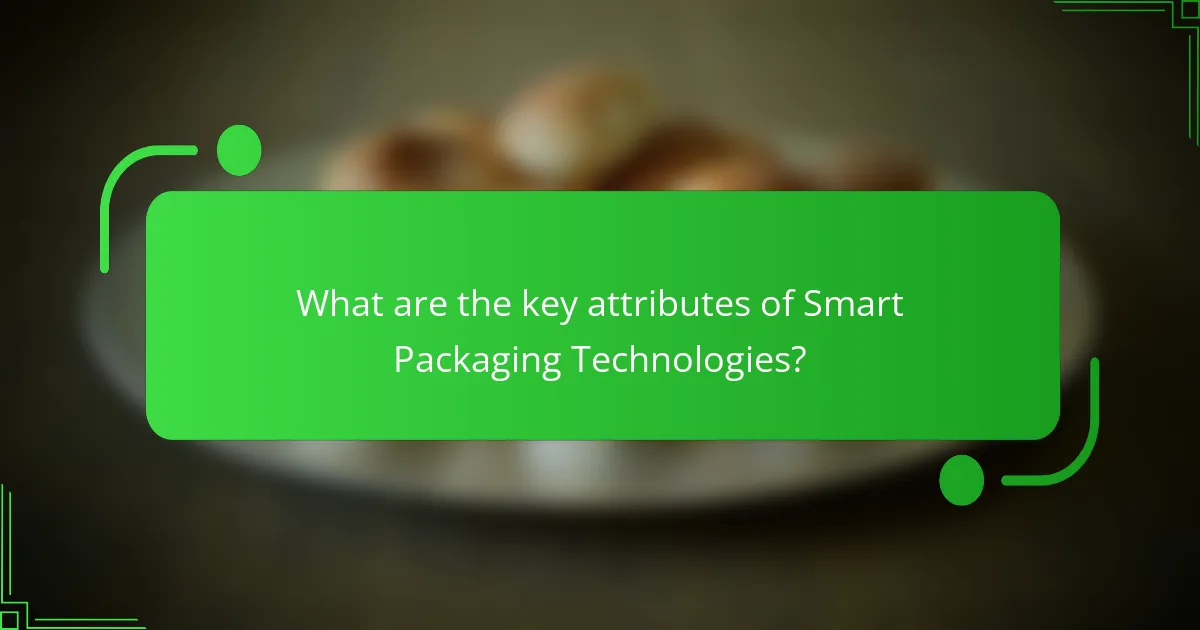
What are the key attributes of Smart Packaging Technologies?
Smart packaging technologies are innovative solutions enhancing product preservation and consumer interaction. Key attributes include active packaging, which actively interacts with the product environment to extend shelf life. Another attribute is intelligent packaging, which provides information about the product’s condition through indicators or sensors. These technologies can also include biodegradable materials, promoting sustainability. Enhanced traceability is another critical attribute, allowing consumers to verify product origins and safety. Additionally, user engagement features, such as QR codes, facilitate direct communication between brands and consumers. These attributes collectively improve product quality, safety, and consumer experience.
What types of Smart Packaging are available for Greek Yogurt?
The types of smart packaging available for Greek yogurt include active packaging, intelligent packaging, and modified atmosphere packaging. Active packaging interacts with the product to extend shelf life. Intelligent packaging provides real-time information about freshness and quality. Modified atmosphere packaging alters the composition of gases inside the package to preserve yogurt. These technologies enhance the consumer experience and ensure product safety. Research indicates that these smart packaging solutions can significantly reduce food waste and improve product quality.
How do active and intelligent packaging differ in functionality?
Active packaging interacts with the product to extend its shelf life. It can release or absorb substances, such as moisture or oxygen. This helps maintain the quality of the food inside. Intelligent packaging, on the other hand, provides information about the product’s condition. It can monitor factors like temperature and freshness. Intelligent packaging often includes sensors or indicators. These features inform consumers about product safety and quality. Both types enhance the consumer experience but serve different primary functions.
What materials are commonly used in Smart Packaging for Greek Yogurt?
Common materials used in smart packaging for Greek yogurt include plastics, metals, and paper-based materials. Plastics such as polyethylene and polypropylene are frequently utilized for their flexibility and barrier properties. These materials help maintain freshness and extend shelf life. Metals, particularly aluminum, are often used in foil packaging to provide a strong barrier against moisture and light. Paper-based materials can also be incorporated, especially when combined with biodegradable coatings for sustainability. Smart packaging may include sensors or indicators embedded within these materials to monitor freshness or temperature, enhancing consumer engagement.
Why is consumer feedback important for Smart Packaging development?
Consumer feedback is crucial for Smart Packaging development because it informs design and functionality. Understanding consumer preferences helps manufacturers create packaging that meets user needs. Feedback highlights aspects like usability, aesthetics, and sustainability. For instance, a survey by Smithers Pira revealed that 72% of consumers prefer eco-friendly packaging. This data drives innovations in materials and processes. Additionally, consumer insights can identify potential issues before product launch. Addressing these concerns enhances customer satisfaction and brand loyalty. Overall, integrating consumer feedback leads to more effective Smart Packaging solutions.
How can brands leverage consumer insights to improve Smart Packaging?
Brands can leverage consumer insights to improve Smart Packaging by analyzing customer preferences and behaviors. This analysis allows brands to tailor packaging features that resonate with consumers. For instance, brands can implement interactive elements based on feedback about user engagement. Research indicates that 70% of consumers prefer packaging that provides additional information about the product. Brands can also utilize data on sustainability preferences to create eco-friendly packaging options. By incorporating these insights, brands can enhance customer satisfaction and loyalty. This approach not only meets consumer demands but also drives sales growth and market differentiation.
What challenges do companies face in implementing consumer-driven Smart Packaging?
Companies face several challenges in implementing consumer-driven Smart Packaging. High costs of technology development and integration are significant barriers. Many companies struggle with the complexity of the technology required for smart features. Ensuring data security and privacy for consumers is also a major concern. There is often a lack of standardization in smart packaging solutions across the industry. Additionally, companies may face resistance from consumers unfamiliar with new packaging technologies. Educating consumers about the benefits of smart packaging is essential but can be resource-intensive. Finally, companies must navigate regulatory requirements that vary by region, complicating implementation efforts.
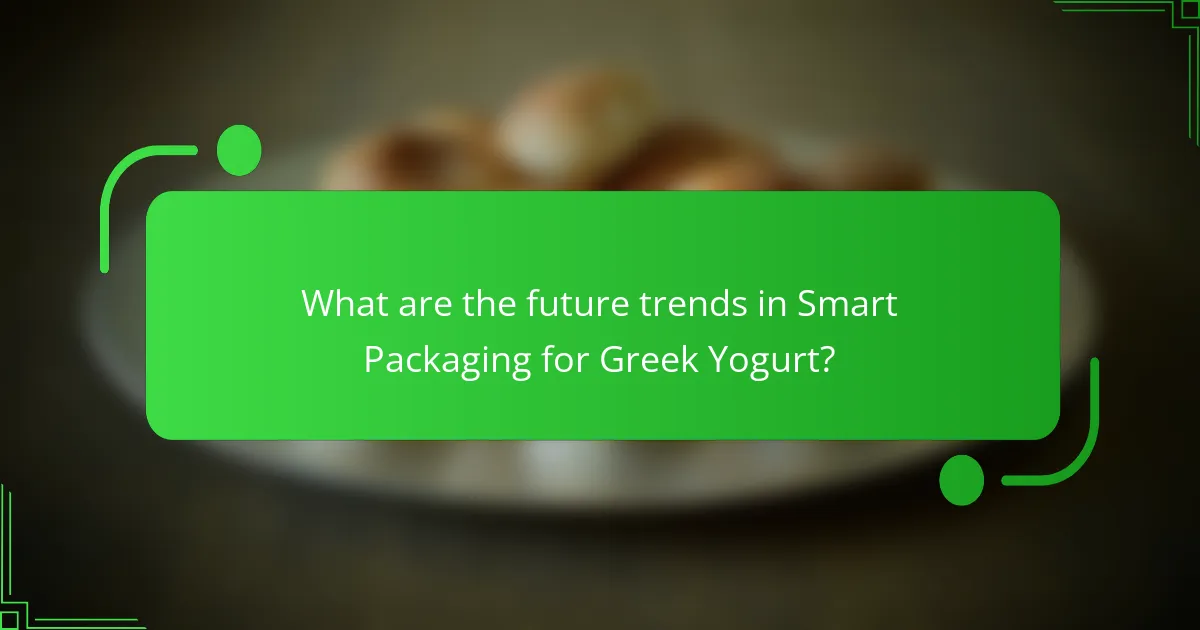
What are the future trends in Smart Packaging for Greek Yogurt?
Future trends in smart packaging for Greek yogurt include increased use of active packaging technologies. These technologies enhance shelf life by absorbing oxygen and releasing preservatives. Another trend is the integration of QR codes for consumer engagement. Consumers can scan codes for nutritional information and recipe ideas. Biodegradable materials are also gaining traction, aligning with sustainability goals. Smart sensors that monitor freshness and temperature are being developed. These sensors provide real-time data to consumers and retailers. Additionally, personalized packaging based on consumer preferences is emerging. This trend tailors the product experience, increasing customer satisfaction. Overall, smart packaging for Greek yogurt is evolving towards sustainability, interactivity, and enhanced preservation.
How is technology evolving in the Smart Packaging industry?
Technology is evolving in the Smart Packaging industry through advancements in materials, sensors, and digital integration. New materials enhance barrier properties and sustainability. Sensors are being developed to monitor freshness and detect spoilage. Digital integration allows for real-time tracking and consumer interaction. Innovations like QR codes and NFC technology enable consumers to access product information easily. Companies are increasingly focusing on eco-friendly packaging solutions. Research shows that smart packaging can reduce food waste by up to 50%. These developments are shaping a more efficient and consumer-focused packaging landscape.
What innovations are expected to emerge in Smart Packaging for Greek Yogurt?
Innovations expected in smart packaging for Greek yogurt include active packaging technologies that extend shelf life. These technologies can incorporate oxygen scavengers and moisture absorbers. Smart labels are also anticipated, providing real-time freshness indicators. These labels can change color to signal spoilage. Biodegradable materials are likely to gain traction, reducing environmental impact. Additionally, interactive packaging may enhance consumer engagement through QR codes. These codes can link to nutritional information or recipes. Overall, these innovations aim to improve product quality and consumer experience.
How can sustainability be integrated into future Smart Packaging solutions?
Sustainability can be integrated into future Smart Packaging solutions through the use of biodegradable materials. These materials reduce environmental impact and enhance product lifecycle. Companies are increasingly adopting plant-based plastics and recycled content in their packaging. Smart Packaging technologies can also include features like freshness indicators. These indicators help minimize food waste by signaling optimal consumption times. Additionally, digital tracking can optimize supply chains and reduce carbon footprints. Research shows that sustainable packaging can increase consumer preference for products. A study by Smithers Pira indicates that 72% of consumers are willing to pay more for sustainable packaging options.
What best practices should brands follow when adopting Smart Packaging for Greek Yogurt?
Brands should focus on user-friendly design when adopting Smart Packaging for Greek Yogurt. This includes clear labeling of nutritional information and usage instructions. Incorporating interactive elements, such as QR codes, enhances consumer engagement. Sustainability is crucial; brands should use eco-friendly materials for packaging. Real-time monitoring features can improve freshness and reduce waste. Ensuring compatibility with existing supply chain systems is essential for efficiency. Conducting consumer research helps tailor packaging to target preferences. Lastly, compliance with food safety regulations must be prioritized to maintain trust and safety.
How can brands effectively communicate the benefits of Smart Packaging to consumers?
Brands can effectively communicate the benefits of Smart Packaging to consumers by highlighting its convenience and freshness. Clear labeling can inform consumers about the technology used. Demonstrating how Smart Packaging extends shelf life can enhance consumer trust. Engaging visuals on packaging can attract attention and convey key benefits quickly. Brands should utilize social media to educate consumers about Smart Packaging features. Providing interactive experiences, such as QR codes, can offer additional information. Customer testimonials can reinforce the positive impact of Smart Packaging. Research shows that 70% of consumers prefer brands that provide transparent information about their products.
What considerations should be made for regulatory compliance in Smart Packaging?
Smart packaging must comply with food safety regulations. These regulations ensure that materials used do not contaminate food products. Compliance with the FDA’s Food Contact Notification is essential in the United States. The European Union also mandates compliance with Regulation (EC) No 1935/2004 on materials intended to come into contact with food. Additionally, smart packaging technologies must adhere to labeling requirements. Accurate labeling informs consumers about the packaging’s features and safety. Environmental regulations regarding recyclability and sustainability are also crucial. Non-compliance can lead to legal penalties and harm consumer trust.
Smart packaging technologies for Greek yogurt encompass innovative solutions that enhance product preservation, improve freshness, and foster consumer engagement. Key features include freshness indicators, QR codes, and active packaging that interact with the product environment to extend shelf life. These technologies not only reduce food waste by providing real-time freshness data but also promote transparency and sustainability, aligning with consumer preferences. The article explores the specific attributes, benefits, and future trends of smart packaging, as well as its impact on consumer purchasing decisions and brand loyalty.
